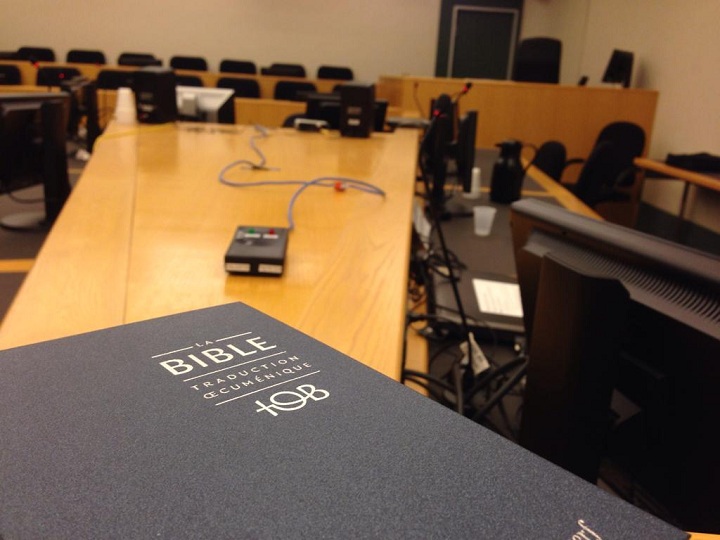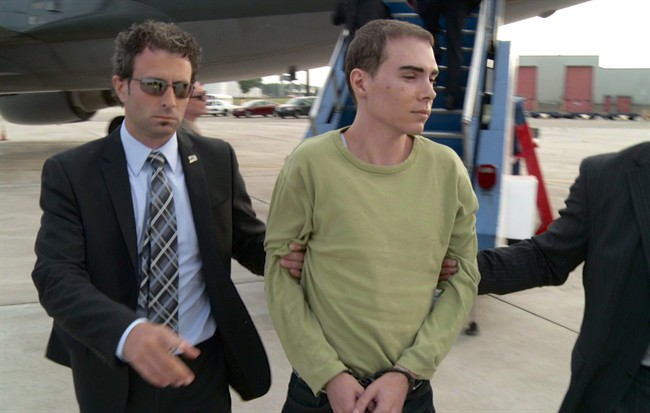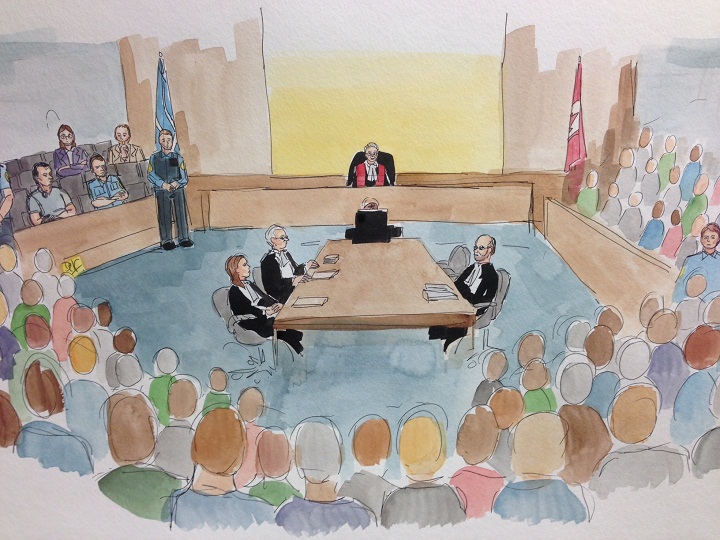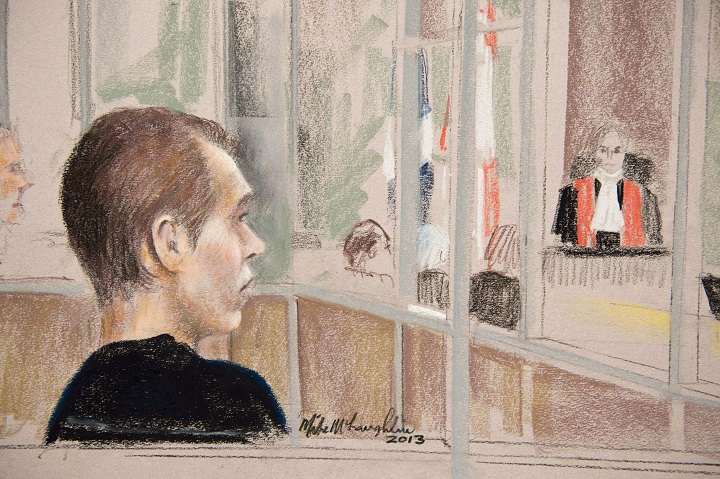WATCH ABOVE: One of the most disturbing crimes in decades is finally before the court. The Luka Magnotta murder trial is now underway. Magnotta admitted killing Chinese engineering student Jun LIn, but has pleaded not guilty. Mike Armstrong explains.

LATEST NEWS:
- Magnotta admits to killing 33-year-old Jun Lin
- Magnotta admits to the facts of the charges
- Magnotta has pleaded not guilty to all charges
- Magnotta’s lawyer says his client is not criminally responsible
- Judge says it’s up to the jury to determine if Magnotta was of sound mind
- Trial is expected to last six to eight weeks
MONTREAL — Luka Magnotta admitted to the 2012 slaying of Jun Lin, though his lawyer is arguing he is not criminally responsible, citing mental illness.
The admission was revealed shortly after the proceedings began in Montreal while Quebec Superior Court Judge Guy Cournoyer addressed the 14 jurors hearing the trial.
With this, the determination of whether Magnotta, 32, is guilty or not rests on whether he was of sound mind during the murder.
Sitting in a large and secure prisoner’s box, Magnotta leaned forward to enter five not guilty pleas to the charges of first-degree murder, committing an indignity to a body, publishing obscene material, criminally harassing Prime Minister Stephen Harper and other members of Parliament, and mailing obscene and indecent material.
READ MORE: What do we know going in to the Magnotta trial? What will the proceedings reveal?
- Premier Moe responds to Trudeau’s ‘good luck with that’ comment
- Drumheller hoping to break record for ‘largest gathering of people dressed as dinosaurs’
- As Canada’s tax deadline nears, what happens if you don’t file your return?
- Planning a summer trip to Quebec’s Îles-de-la-Madeleine? You’ll have to pay up
During his opening statement, Magnotta’s defence lawyer Luc Leclair said the defence would be “not criminally responsible,” saying Magnotta suffers from schizophrenia and didn’t know what he was doing at the time 33-year-old Lin was murdered.
“Mr. Magnotta is going to raise the issue of mental disorder,” Leclair told jurors. “A person is not criminally responsible if they were not of sound mind at the time of the crime.”
Defence argues not criminally responsible
His defence plan will include presenting evidence to the jury in hopes of proving Magnotta suffers from schizophrenia and was not able to grasp the severity of the acts he committed, Leclair said.
The Toronto-based criminal defence lawyer told the jury they would likely hear and read reports from doctors and psychiatrists who had contact with Magnotta over the past several years and offered a range of diagnoses. Leclair also said he is hoping Magnotta’s father, who he said also suffers from schizophrenia, will testify.
READ MORE: The art of jury selection, as told by criminal defence lawyers
“I intend to show you that at the time of the events, he was not criminally responsible,” Leclair said as he concluded his opening statement.
In April 2012, just one month before the death of Lin, Magnotta was referred to a psychiatrist at the Jewish General Hospital in Montreal where he underwent a one-hour assessment and was diagnosed as borderline personality disorder, Leclair said.
Had that assessment gone differently, he told the jury, “we may not be here today.”
More than two years have passed since the gruesome murder of Lin, a Concordia University student, gripped Canadian and international minds alike when the search for Magnotta turned into an international manhunt, ending June 4 when he was apprehended in Germany.
Lin’s torso was discovered behind a Montreal apartment building in May 2012, around the same time a dismembered foot arrived at the Conservative Party’s head office in Ottawa through the mail.
Gallery: Magnotta case heads to trial
A video purporting to show the murder was also posted online around that time, with Montreal police subsequently linking the video to the discovery of the body parts.
Magnotta fled the country, and was eventually found and arrested at an Internet cafe in Berlin.
READ MORE: Father of Magnotta’s alleged victim wants ‘obscene’ evidence kept under wraps
Lin was born in Wuhan and had only been in Canada since 2011, where he was studying computer engineering at Concordia University.
Crown argues intent
During the Crown’s opening statements earlier Monday morning, Crown prosecutor Louis Bouthillier told the jury members they would have to see graphic photos collected from the Montreal apartment Magnotta was renting and where he committed the murder, as well as the graphic video.
“In late May 2012, surveillance camera in the lobby of that apartment building shows Mr. Magnotta coming in with Jun Lin,” Bouthillier said. “These images of the surveillance camera are the last images of Mr. Lin alive. He will be killed by Magnotta a few hours after that.”
As he laid out his plans for the trial, Bouthillier said evidence and testimony would prove Magnotta had planned a murder and the videotaping of it months before Lin’s death.
During the investigation in May, police took photos of the crime scene, brought in a forensic pathologist and interviewed the apartment janitor who discovered Lin’s torso in a locked suitcase among a pile of garbage. All has been entered as evidence, Bouthillier said.
Witness testimony begins
The Crown’s first witness, Montreal police forensic investigator Caroline Simoneau, was on the stand for almost two hours Monday showing almost 160 photos to the court.
There were many photos taken from the area around the apartment building, as well as beside the building where police collected several black, plastic garbage bags and found the suitcase containing Lin’s torso.
The court was shown the photos, most of which were of inanimate objects contained in the garbage bags — tools, knives and scissors, articles of clothing and documents inscribed with Magnotta’s name.
READ MORE: Luka Magnotta trial: How many details do you want to be told?
Among those images were some more graphic, including items described as wet and covered in a reddish liquid, sometimes dripping.
The most graphic images were usually preceded with a warning from the witness they may be disturbing. Inside one garbage bag, police found part of a leg wrapped in two other bags. Inside another, a small, black dead dog. And inside another, even more body parts.
The jury looks on
Magnotta is being tried by a jury of his peers who sit in two rows not far from the prisoner’s box.
Fourteen jurors are hearing the case, although only 12 will take part in the final deliberation. Quebec Superior Court judge Guy Cournoyer said he will select those 12 by picking numbers at random.
The jury-selection process spanned eight days earlier this month. Beyond the requisite for each potential juror to demonstrate a proficiency in both French and English, Cournoyer sought men and women capable of seeing, hearing and stomaching the evidence, much of which is expected to be considered gruesome.
A pool of 1,600 potential jurors was summoned and eventually whittled down to about 300. The court then vetted prospective jurors each day until they selected the 16 on the current list that included nine women and seven men with jobs ranging from stockbroker and junior college professor to web developer and auditor.
The final two who made that list were dismissed immediately when the proceedings began Monday morning.
The trial is expected to last six to eight weeks with the Crown potentially calling up to 60 witnesses.
The amount of time the defence will require, however, is less clear as its list of witnesses is still in the making.
The Montreal courtroom where proceedings are taking place over the next few weeks includes a large, secure prisoner’s box where Magnotta will spend his days.
Beyond the space for court staff, lawyers and the jurors, there are only 13 seats in the room, with five reserved for media, another five for members of the public, two for the victim’s father and a translator, and one for a member of the defence team.
Two overflow rooms with video feeds to the court room were opened Monday in order to accommodate the large number of local, national and international journalists covering the first day of the trial.
-With files from The Canadian Press






















Comments